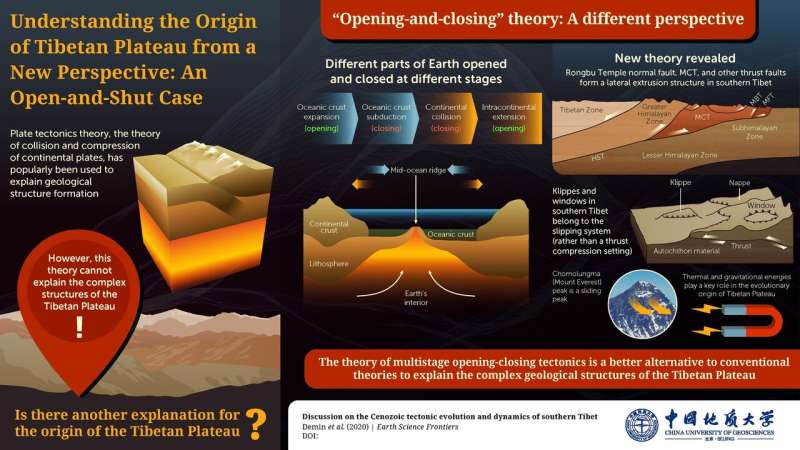Geologists shed light on the Tibetan Plateau origin puzzle: an open-and-shut perspective

Earth's geographical surfaces formed over millions of years, and various theories aim to explain their formation. The most popular theory, called plate tectonics, states that Earth's outermost layer is a dynamic system consisting of slowly moving plates, also known as tectonic plates. As theses plates move, they come close to each other and collide, or drift away from or slide past each other, causing tension or rupture along their boundaries. During the enormous compression force along the rupture line of two plates, a slab of the earth can uplift. The uplifted piece of land gives rise to geographical structures such as mountains or plateaus on the landscape of the earth.
The Tibetan Plateau, the highest plateau in the world, is believed to have been formed through one such tectonic process, when the Indian and Eurasian continental plates collided with each other. The landscape of this enigmatic plateau consists of unusual geological structures that have baffled geologists globally. For example, many independent geological units of different structures and ages are placed next to each other in a way that cannot be explained by a single tectonic event as per the existing theory. Intrigued by this, a group of scientists at the China University of Geosciences, led by Dr. Liu Demin, investigated in detail the geological structures of the southern Tibetan Plateau.
Dr. Demin says, "The southern Tibetan Plateau has a complicated geological structure that cannot be explained by the existing plate tectonics theory. Our study uses a new idea to explain some unusual tectonic structures that are part of the southern Tibetan Plateau."
The results of the study are published in Earth Science Frontiers.
To begin with, the scientists analyzed ancient tectonic ruptures in the form of boundaries between the distinct geological regions. The South Tibet Detachment System (STDS) is one such boundary that runs parallel to the Himalayan range for more than 2,000 km.
The researchers analyzed the geological data of STDS and other structures in the region, such as the Rongbu Temple normal fault and the Main Central Thrust (MCT), to trace the possible chain of events related to the evolution of these boundaries. They speculated that instead of a single collision-compression process (as per the existing theory), these boundaries were created in different periods altogether, through a series of tectonic events that date back to the early Cenozoic era (a geological era that extends from 66 million years ago to the present day) and occurred in multiple stages.

According to this model, called the opening-closing theory, the upper layer or crust of a prehistoric ocean called the Neo-Tethys ocean expanded or opened, and a part of the oceanic crust moved under the other, resembling a closing movement. The continental plates also followed a similar process of opening and closing as they moved toward and away from each other. This chain of events gave rise to the structures of the Tibetan Plateau.
Using this model, the scientists were able to deduce that the Rongbu Temple normal fault and the MCT were formed earlier than the STDS was. Further, they revealed that two tectonic units in the Chomolungma region, klippes and windows, were actually the result of gravitational gliding (as opposed to compression, as previously believed) and thus should be characterized as extensions and slips, respectively.
Dr. Demin says, "Thermal energy and gravitational potential energy in the deep Earth played a key role during this opening-closing evolutionary process."
The geology of Earth's surfaces has changed over millions of years through continuous evolutionary processes. In this study, the scientists have unraveled part of the mystery surrounding the complex geological structures of the southern Tibetan Plateau. "A deeper understanding of the opening-closing process requires us to focus more on the detailed geological record for evidence of continuous rather than temporal processes," says Dr. Demin.
The research team now plans to study the differences between the opening-closing view and the plate tectonic theory in detail to shed further light on the genesis of the Tibetan plateau.
More information: Discussion on the Cenozoic tectonic evolution and dynamics of southern Tibet, Earth Science Frontiers, 2020.
Provided by China University of Geosciences





















